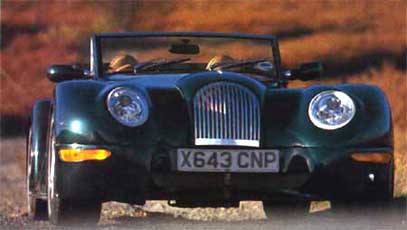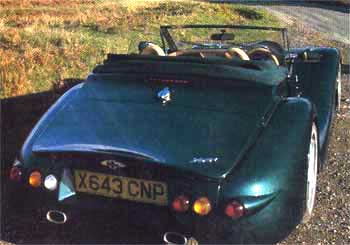


Morgan
Aero 8
After
90 years, Morgan produces a thoroughly modern Milieu powered by a 286 hp
BMW V-8.
BY RAY BUTTON
It is difficult for most Americans to fully comprehend the popularity of the Morgan, with its peculiar vintage styling, not to mention the quaint, old-fashioned Britishness of the whole business.
Since 1910, the Morgan Motor Company has been the main employer in the sleepy country town of Malvern Link in Worcestershire, England. It still operates in its original buildings.
Morgans had to provide wind-in-the-hair motoring, and they had to be made by hand. In Britain, buyers are even prepared to wait five years from order to delivery.
As Car and Driver first informed readers in the June 1999 issue), a new, thoroughly modern Morgan would be launched at the 2000 Geneva auto show, with deliveries to British customers set to start at the end of the year.
Called the Aero 8, the new Morgan has an aluminum chassis, a state-of-the-art BMW V-8 engine, and advanced features - at least for Morgan - such as an independent rear suspension, power steering, and disc brakes at all four wheels. It signals a reorganization that will allow the factory to double production to 24 cars a week, or about 1000 per annum. And that, we are told, is because Morgan is heading for the United States, with this fully certified, crash-tested, air-bagged, and bumper-compliant Aero 8. The target date for its arrival is the summer of 2002. Creating a high-tech Morgan for the 21st century was tricky. For years, the company rejected the idea of a completely new car as too difficult a task. Besides, it was back-ordered for five years. But in 1996, Charles Morgan, grandson of company founder H.F.S. Morgan, decided to take the plunge.
Racing had shown the potential of an aluminum chassis that could fit under a body of Morgan proportions. That chassis was originally designed by Jim Randle, the former engineering chief of Jaguar, but the development of the Aero 8 has been the work of veteran Morgan tuner and racer Chris Lawrence. The task of shaping a body that would confer stability at speeds as high as 160 mph, yet be unmistakably a Morgan, was taken on by Charles Morgan himself.

Inspired
by the classic French and Italian roadsters of the 1930s, Charles did sketches
of his ideas for the new car but admits that it was actually shaped by
a kind of reverse engineering - they made it up as they went along. The
chassis was there and body parts were made, fitted, and modified, the appearance
being approved by the company's small management team at each stage. Sad
to say, the result is a car that looks as if it were designed by a committee.
The headlight units that are flushed into the wide, sweeping fenders give
it a cross-eyed appearance. A large but essential air splitter forms an
awkward "shelf' under the dummy traditional radiator grille, and the drooping,
squared-off tail is at odds with the generous curves of the front.
So this is a Morgan, but not as we know it. The - simple and flexible - steel ladder frame of the old car has been replaced by a stiff, lightweight chassis of 32 aluminum alloy panels, bonded and riveted together, using specially prepared sheet metal and a construction process developed by Alcan.
The suspension has rocker arms and inboard coil-over shock units instead of the ancient sliding-pillar arrangement at the front, and wide control arms replace the cart-sprung rear axle. Ultra light five-spoke O-Z magnesium alloy wheels are used, 18 inches in diameter and 9.0 inches wide.
Spherical steel joints are used throughout the suspension, with rubber bushings only at the damper mounts. There are two curiosities about the suspension. The coil-over shock units at the rear are "floating" both ends are mounted on the control arms, at the outboard end of the lower arm, inboard on the upper, and there are no anti-roll bars. Lawrence says:
"The roll center is low, and I prefer to balance the car's handling with the spring rates."
Although its aluminum body panels are mostly shaped by machine, the new car maintains Morgan's coachbuilding tradition by mounting them on a wooden frame that's bolted to the chassis. So the natural- colored ash in and around the cockpit is not the usual thin veneer for decoration but a solid part of the car's structure.
This is the most powerful and most expensive Morgan ever. Its 286 horse power comes from the 4.4-liter BMW V-8 engine found in the 540i and 740iL. The six-speed manual Getrag gearbox is also the one used by BMW.
Although the open-topped Aero 8 is a far cry from the sanitized efficiency of a BMW sedan, the engine remains sweet, smooth, and punchy, enhanced by the Morgan's more tuneful exhaust. Since the Aero 8 weighs only 2200 pounds, the per formance is mighty: 0 to 60 mph in about 4.5 seconds, with a top speed of about 160 mph.
Even the most committed fan of the old models will appreciate the leap forward that the Aero 8 represents. A Morgan Plus 8 with a Rover V-8 is fast on a smooth road but hard, jerky, and difficult to handle on a bumpy one. The Aero 8 is eager but easy and remains stable and surprisingly comfortable even over bad pavement. It has power and torque to spare, so that you can flick the tail with a prod on the throttle or spin the wheels just for the hell of it.
Control efforts - the pedals, steering, gear change - are not too heavy and nicely matched. The big AP Racing brakes are highly effective but would be more reassuring in bad weather if they included an anti-lock system. The omission of ABS seems illogical, as Morgan has not been shy about incorporating other modern conveniences such as air conditioning, cruise control, a tire-pressure monitoring system, satellite navigation, and windows with built-in heating elements.
The idea of a Morgan used to be nicer than the reality. There is something glamorously sentimental about looking out across a long, tapering hood and sweeping mudguards. That vista remains through the flat windshield of the Aero 8, but the new car now drives much better than it looks. The tight-fitting cockpit and the position of the two seats, just ahead of the rear axle line, make this seem a much bigger car than it is - actually, it is five inches longer and wider than the old Plus 8. With the fabric roof in place (it has a heated glass rear window) it is a bit claustrophobic.
The Aero
8's price of £50,000 ($74,500) in the British Isles ensures that
Morgan will continue with its cheaper traditional models, the 4/4 at £22,000
($32,780) and the Plus 8 at £35,000 ($52,150). But neither the price
nor the looks have deterred more than 500 persons who placed orders for
the Aero 8 before they had even driven one.
Transmission 6-speed manual
Wheelbase 99.5 in
Length 161.0 a
Width 69.0 in
Height 43.0 in
Curb weight 2200 lb
Manufacturer's
performance ratings:
Zero to 60 mph 4.5 sec
Top speed (drag limited) 160
mph
Projected
fuel economy:
European urban 13 mpg
suburban 26 mpg
combined 19mpg